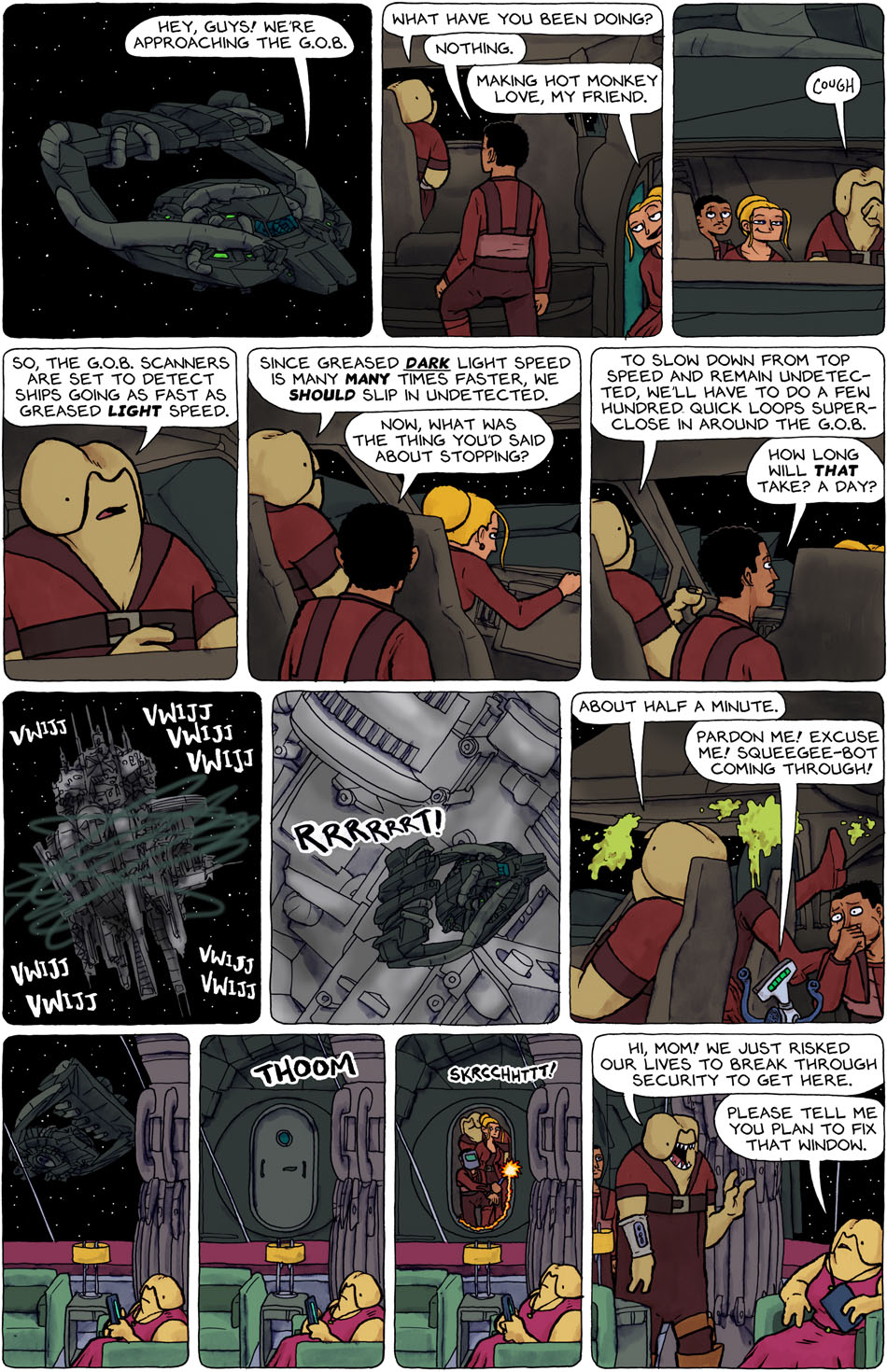
Having some minor technical difficulties today. The site is back up, with any luck the “comments” will be back soon.
Hey, you have one more week to see my show which I have hanging in Fuel Coffee in Wallingford! It’s this show.


Having some minor technical difficulties today. The site is back up, with any luck the “comments” will be back soon.
Hey, you have one more week to see my show which I have hanging in Fuel Coffee in Wallingford! It’s this show.

I love the squeegee-bot!
Wait.. wouldn’t during teh deceleration phase the ship be (atleast instantaneously) at greased light speed?
Presumably the scanners aren’t aimed that close to the stations hull.
@Snow_Cat, @Random_Guy is correct. That’s why they have to do it “super-close in.” 🙂
I had no idea Gurf was a prude. Also, the Squeegee-bot may take a holiday at my place during kitty hairball season, yes please.
Great sound effects!
Heh, for like a quarter second there my brain started to spin up into physics mode wondering why angular momentum was different from linear momentum in relation to whatever tech allows them to drop from near-luminal velocity so fast (i.e. why they got dizzy/sick). Then I remembered that would be pointless since the tech in question is undefined…
…Which is the way it should be: besides being a blatant writers crutch, technobabble explanations exponentially increase ones chances of frelling up the science for those who actually enjoy that sort of thing.
Still better than the “inertial dampeners” in Star Trek though. I mean, given the kinds of loads these technologies are designed for, getting dizzy because because you pushed the safe operating range trying to decelerate too fast from effin’ light speed makes a lot more sense than getting bodily tossed about the room just ’cause something exploded within a few hundred feet of your hull. I mean, if that’s all it takes to surprise or overload the dampeners or whatnot, then they won’t stand a snowballs chance on Venus against the kind of actual acceleration/deceleration those ships call normal travel.
Oh god. I’m a massive geek, aren’t I?
If bar-bot, medi-bot, potty-bot, therapy-bot and even skeet-bot get their own tags, why not squeegee-bot too?
One could just as well assume they threw up due to visual stimuli — seeing the G.O.B. swim wildly about, along with the stars and whatever other objects are visible.
@ Tim McCormac: Nah, think about it: from their POV the station would just look like a big wall zipping by off their left side, and the stars would just appear to be scrolling left to right. There’d be some wobble because the ship is flying in irregular loops instead of a flat orbit, but that’s about it as far as motion sickness-inducing visuals go.
In fact “a few hundred loops” taking “about half a minute” around a station that big… the whole thing would just be a blurr, so all they’d actually probably see is a big vague grey something wobbling up and down off to the left while the stars would look like… I dunno, the surface of a river flowing left to right, maybe.
Speaking as an old ex-physics major who regularly complains about the magic gravity generators and sound in space of most science fiction movies, I’ve long learned to just accept something for a sake of a good story.
Basically all this wondering over the rules these imaginary FTL engines have to follow? It helps not to overthink it. How it works is how Chris shows us it works.
For one thing without the “sound in space” the scenes would look dead. So it was added for us who are born into a world where sound exists. (It was tried in the earliest Star Trek but it didn’t look so good silent. So sound was added. As for convenient gravity generators there you have it. Convenience. Has nothing to do with physics and everything to do with drama and entertainment. So until physicists take making movies or tv shows or we all take hard science courses with all movies adjusted to the realities we should just leave it alone as Corpore Metal has.
Glad to see you too, Halip!
@CBob We knew you were a massive geek right at “frelling”, but don’t worry, we all love Jim Henson and Farscape
@von, Bar-bot, medi-bot, and all the other “-bots” you mentioned all play significant roles in the plot and story line. On the other hand, “squeegie-bot” is a minion, rather like “Cop #3” or “Girl with the pink hair” you see in the credits at the end of movies.
(Although such end-credit credits can be misleading. At the end of “The Avengers”, the lantern-jawed creature is only credited as “Man #1” when in fact he is a supervillain known as “Thanos”. So it’s possible that squeege-bot is actually a GOB plant and may undermine their entire mission.
Naah.
@Joal – You must not read much of MAD Magazine. Chris is a cartoonist for it and that magazine is famous for those wonderful sound effects.
As for the other comments: Uber-Geek here too. Superluminal velocities aren’t actually forbidden in physics, just not achievable with the technologies we know of (I’ve been juggling the related differential equations for approaching 40 years). NASA, DARPA and others have been seriously looking at gravitational generators and their reverse for quite sometime now. Again, modern physics does not exclude the possibility of such. But sounds in space? Yeah, that sucks in terms of physical possibility. Actually, even most of outer space still isn’t a perfect vacuum, so a weak sonic propagation is still possible, just really hard to heard. Of course some hypothetical technology could conceivably produce a sound wave imposed over a gravity wave with the same effect as a gaseous medium. If you can do artificial gravity with fine enough control, why not?
I am, in fact, aware of that, Richard. But one shouldn’t take such things for granted, neh? 🙂
I love Emily’s self-satisfied smirk in panel three.
Pingback: Little Dee - 06/04/12 – Delivery
I thought they said that dark drive was just a little faster than light…
@Drachefly, it is! But you’ve lost me, what is the confusion?
I realize this is very late but they’re probably referring to Gurf’s comment about how the dark drive is many times faster than the light drive. “Many times” is not “a little” faster, it ‘s a whole heck of a lot faster.
Personally I’d just chalk it up to a lack of understanding of a new tech they haven’t had time to properly educate themselves on. You know, what with unstoppable unclamped Eebs torching planets and galactic conspiracies and hot monkey lovemaking and all.